White Man’s Game
Air Date: Week of July 28, 2017
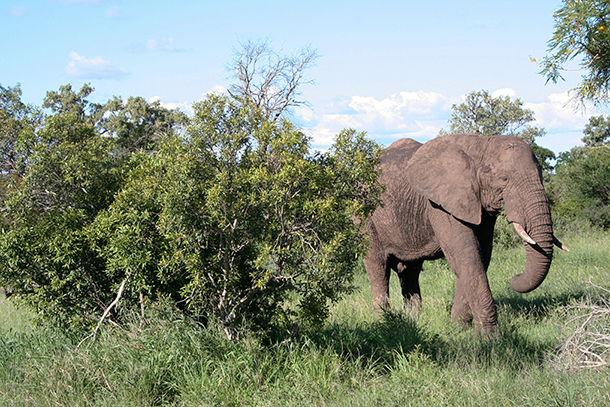
An elephant in Southern Africa. (Photo: Steve Curwood)
Western environmental philanthropy in Africa has often focused on habitat and species conservation. Journalist Stephanie Hanes writes in her new book, White Man’s Game: Saving Animals, Rebuilding Eden, and Other Myths of Conservation in Africa, these well-intended projects can fail if they ignore local culture and beliefs. Using Gorongosa National Park in Mozambique as an example, Hanes and host Steve Curwood discuss the challenge of cross-cultural conservation endeavors.
Transcript
CURWOOD: It’s Living on Earth, I’m Steve Curwood. For thousands of years humans have been changing the environment, but the Industrial Revolution put change on steroids, with Europeans able to explore and exploit some of the remotest natural areas remaining. And no place was more intriguing than Africa.
Today there ware numerous efforts to halt the rapid loss of species and habitat, funded in part by the profits from modern business. But writer Stephanie Hanes says the promise of saving what’s left of nature can sometimes be imperiled by the narrow cultural lens employed by people from the developed part of the world. Her new book focuses on efforts to rebuild Gorongosa National Park in Mozambique, after it was denuded of its animals during a horrific regional conflict. It’s called “White Man’s Game: Saving Animals, Rebuilding Eden and Other Myths of Conservation in Africa,” and she joins me now.
Stephanie Hanes, welcome to Living on Earth.
HANES: Oh, thanks so much, Steve.
CURWOOD: What led you to write this book, "White Man's Game"?
HANES: I was working as a foreign correspondent in Southern Africa and I had just started to write about different environmental stories and different conservation stories, and when I first began doing that, I had gone in with a really simplistic idea of what the story lines were, that there's a good guy, that there's a bad guy, and that the people who are trying to save animals are on the side of the good, and then the bad people are trying to hurt them. And as I started reporting, I realized that it was much more complicated than this, much more interesting, much more political. And in a lot of ways, my book, "White Man's Game," stems from this. I wanted to go under the surface and try to understand why our conservation efforts weren't working the way that we wanted them to.
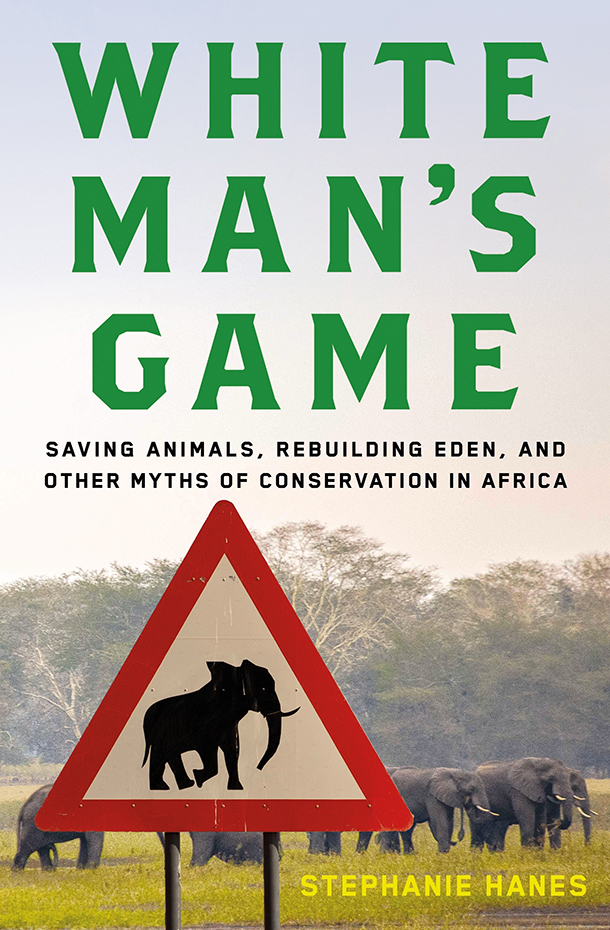
White Man's Game book cover. (Photo: Courtesy of Stephanie Hanes)
CURWOOD: In your book you talk about how Africa became so associated with the idea of adventure. You also say that often our stories of Africa and nature there are, well, they're really about us, especially, perhaps, in our efforts to provide aid. What brought you to this realization?
HANES: Well, there is a long history of western explorers and adventurers going into different parts of Africa and then bringing back these spectacular stories, and in a lot of ways we've never really gotten away from that narrative. And you see that today in the safari brochures that promise people, you know, the African experience of a lifetime, and here is your African adventure. And as I was reporting about both conservation issues and development aid, I saw these themes of adventure come up again and again and again. And they did seem to be a lot more about the travelers than the people or creatures that actually live there.
CURWOOD: You call your book "White Man's Game". To what extent do you think racism is a problem in these conservation efforts? I'm thinking of here in the United States, for example, that the National Parks system was whites-only at the very beginning. How much do you think the difficulties in conservation effects there are due to the racial divide?
HANES: There's a nasty history of national park creation in southern Africa. Those parks were primarily designed for colonial white people and often involved removing black Africans who lived in them to other places. So, what's seen as a conservation triumph in a lot of these places began with personal tragedies for the people who live there. I wouldn't want to accuse people who are going in now with conservation goals of racism. I don't think that it’s as simplistic as that, but I do think that these racial tensions and these cultural tensions are clearly there.
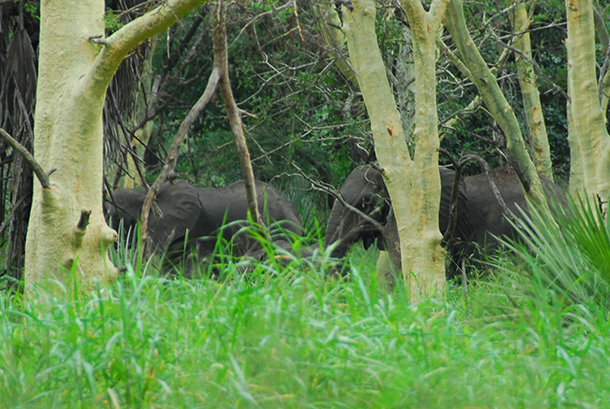
Elephants in Gorongosa National Park in Mozambique. (Photo: F Mira, Flickr CC BY-SA 2.0)
Somehow, our pattern, when we've gone into developing parts of the world, which also happen to be those parts of the world we often find our ecological hotspots in, we don't see the complexity there. We come in with an idea of what is good and what is effective and what we think should happen and often these thoughts are really well-meaning. But we don't realize that we're not going onto this blank slate, we're not going onto a place that just needs help. If only we could come and add our expertise. We're going into incredibly complex and very different places.
CURWOOD: What you're saying, essentially, is that there’s a problem -- you call it the white man's game -- some would have called it in the past perhaps the so-called “white man's burden”?
HANES: It's a colonial term for the idea that it was the responsibility of the civilized North to come and help the South, go and help Africa, and it was the white man's burden to uplift the rest of the world. There's also a great Kipling poem that takes a harsh look at that. And that's actually where I came up with the name of the book, and “game” being game parks or game animals as well as the other indication.
CURWOOD: So, Mozambique, of course, has a difficult and complex history, and at the end of the day much of the sort of charismatic megafauna that we know from Southern Africa -- the elephants, the lions and leopards and all that -- were gone. They were dead in much of the country. And you write about Gorongosa, where philanthropist, conservationist, entrepreneur, Greg Carr went to this particularly beautiful place to try to remake what had been a national park. Why did you pick Gorongosa as your case study for looking at what you call sometimes “myths of conservation” in Africa?
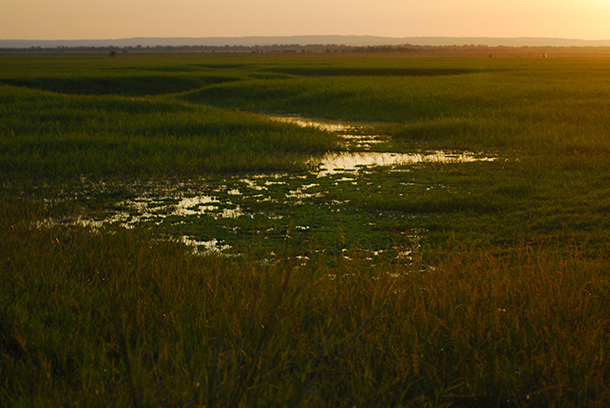
Gorongosa Park at sunset. (Photo: F Mira, Flickr CC BY-SA 2.0)
HANES: I first ended up at Gorongosa because I was reporting a series with the Pulitzer Center on Crisis Reporting about the intersections between environmental degradation and conflict zones. And in the course of reporting that series, I spoke to a source who said, "Well, if you're looking for a good news story, maybe check out the Gorongosa National Park in central Mozambique." And I thought, “Great, this is the one good-news piece that I can have in this series, and it will be an easy story to do.” And I went there, and in a way it was a really easy narrative, at first. It was a place that had been destroyed that was coming back, that was going to be beautiful again.
But there was also something more. And the longer I stayed there, and the longer I reported, the more I saw that there were all these complexities going on underneath the surface, and that narrative that was so easy wasn't the narrative to the people who live there, to at least some of the people who live there.
CURWOOD: You talk about the tension between the people who live near the park and the park itself. In fact, you open your book with a scene of a person who had worked putting up a fence to keep in some transferred animals after he was let go from that job coming back and killing some of those animals to make money.
HANES: The person that I write about in the book got a temporary position at the park to help build a sanctuary fence for new animals that the park was bringing in from other countries. He did end up going back and killing some of those animals and was eventually arrested for snaring still other animals in the park. He was a poacher, and he said that unapologetically. There wasn't the same morality attached to it. He was poaching because he needed to feed his family and make a couple of extra dollars so he could buy schools supplies for his little kids. The reaction was then to bring him and put him in forced work duty for a number of months to have him pay off the fines for his poaching.

The “Serra de Gorongosa” mountain complex, close to Gorongosa National Park. (Photo: Ton Rulkens, Flickr CC BY-SA 2.0)
And so, what started as this effort to give people jobs in the park and to build goodwill and to convince them that this national park was really important for them, to be some place that should be protected, turned for this family and this person into yet another instance of outsiders coming in and hurting them.
CURWOOD: In your book, you talk about how well-meaning Westerners often seem to end up lecturing the indigenous people about their own environments. In particular, E.O. Wilson -- very smart biologist, developed the biophilia hypothesis -- goes to organize a bio blitz there. I get the impression you think that Wilson's efforts there were rather condescending. I mean, how do you achieve a balance between respecting local expertise and achieving conservation goals?
HANES: I'm not sure if I would say that E.O. Wilson's actions there were inherently condescending. I think that there is a problem with people who don't have any familiarity with a particular place going in and declaring themselves to be the experts there. There is, they certainly hold an expertise, and I'm not trying at all in the book to negate that. I think that Wilson's work is incredible.
There are a number of instances where Western conservationists have gone to places and have said that people living there should change their behavior in this way or that way. A lot of times local villagers are presented as uneducated or that they are primitive. They might not have the same scientific background or education, but there's an awful lot of knowledge there, and I think that that gets lost a lot when people come into a place unaware.
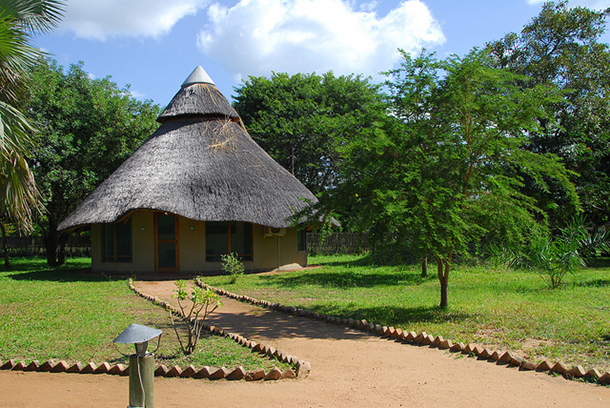
An African rondavel-style building in Gorongosa National Park. (Photo: F Mira, Flickr CC BY-SA 2.0)
CURWOOD: One of the big premises of the whole Gorongosa effort is that tourists will be invited. How welcome, in fact, are tourists to this place by the people who have lived there literally for thousands of years?
HANES: Well, there are two answers here. The first one is that there are not many tourists in Gorongosa right now. That was the original goal. That goal has shifted, and that’s something that is another issue with conservation programs that I saw when I was reporting there, is conservation programs merge increasingly into development aid programs. But going back to tourism, that's a big question throughout southern Africa. Who are these parks geared toward? Originally, this project started with the idea that there would be a huge number of foreign and Mozambican tourists coming, making the parks sustainable with the tourism fees, and that hasn't happened at all.
CURWOOD: Gorongosa Park, which Greg Carr was working mightily to repopulate with animals and conserve, the national government awarded – if I could say that word -- Mount Gorongosa, a very ecological place. At the end of the day, it led to people at the park pushing to resettle the people who were already there. Tell me that story and the impact of those efforts.
HANES: When Greg Carr and his scientists arrived, they started worrying that deforestation on that mountain was ruining the ecosystem, and fairly soon would destroy the entire ecology of the park if it wasn't stopped. So, the park began lobbying the central government, which happens to be an opposition government, from money of the people within that particular area. So, they are on different political sides. The park started lobbying the central government to put the mountain within the park's borders. Eventually, they did this.

Gorongosa National Park Patron, Leader & Philanthropist Greg Carr. (Photo: USAID Mozambique, Flickr CC BY-NC 2.0)
When I was there, many of the people who lived on the mountain told me that they were incredibly upset about this. For them, this mountain was an incredibly important spiritual place. It had also, for a long time, been the epicenter of resistance there. People didn't want the park to own it. They told me they were worried about this outsider coming and stealing their mountain. Greg said he didn't want to force people to resettle. He expected people would move down on their own. Some people on his staff said they did want to force people to resettle.
What happened is that a few, a little bit after the park got control of the mountain, violence broke out there again in a resurgence of civil war tensions which had been quiet for quite a while. And a lot of the people had to flee the mountain on their own. And a lot of people came down because they wanted to be away from the fighting.
P
CURWOOD: In your book, Stephanie, you talk about the traditional culture there and the role of spirits. For example, you point out that when Greg Carr came up Mount Gorongosa, he showed up in a red helicopter, which was a red flag, culturally. That helicopter represented a “gamba”, the spirit of a soldier who been killed far away from home and was really pretty upset, and would mean that more trouble was coming. In reality, conflict returned to the area. So, in other words, folks who looked to the spirit to tell history said, we'll have conflict, and sure enough conflict came. And those weren't the people who pushed the conflict, by the way. They just said the conditions of conflict had now been set.

Gorongosa Park entrance sign. (Photo: F Mira, Flickr CC BY-SA 2.0)
How did that make you feel when you understood that, and to what extent do conservationists need to pay attention to this question of traditional culture and the spirits?
HANES: I think that conservationists need to pay a lot of attention to the cultures of areas in which they would like to work. What I was surprised by and stunned by, in a way, was how accurately the people who lived there had predicted what would happen. You can't debate with the fact that there were these instances that happened, that people who live there said were part of this pattern of spiritual displeasure which would lead to violence, and indeed it led to violence. So, you know, in terms of how I felt, it was just another example and another piece of proof for me that stories are so very powerful, and that to ignore them or to belittle others as not being logical or scientifically-factual or truth in the conservation, Western, scientific, progressive sense of it doesn't mean that they're any less true. And those conflicts do create real violence, those conflicts of stories.
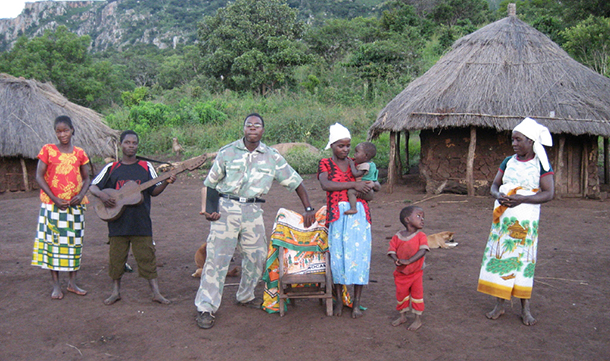
Renha Kueri (right) with her family. They live on Mount Gorongosa in Mozambique. (Photo: Ton Rulkens, Flickr CC BY-SA 2.0)
CURWOOD: Is this a natural history book or a philosophy book?
HANES: I think that this book holds incredibly important truths for the way that we are in the world right now. In a lot of ways, I saw Greg Carr as a metaphor for America and our country, and the way that we go about the world. We're connecting with each other more in some ways, and we're communicating and understanding each other less. So, in a way it is a philosophy book in the sense that it is looking at a really big question of, how do we get past these divides that are tearing up everything from our country to our world. So, I would say both. [LAUGHS]
CURWOOD: Before your book was even published, you faced a lot of criticism about it, so much so that you essentially dedicated a chapter to the criticism of the very end of your book. How do you think people are going to respond now, that your book is actually out?
HANES: I don't know. I'm glad that it will give people the chance to read it. Now, I wasn't surprised that there were some people who were upset by the book. People are working on what they believe is good. It's not easy to be criticized. I was surprised that people who are scientists and who work in fact-based missions had such a virulent reaction before they had never read a word. That seemed like a problem to me.
CURWOOD: Your overarching point in this book seems to be that stories often become romanticized and through that perspective become, well, rather limited. Gorongosa Park, although not a bad thing, comes with consequences, it seems that you're telling us. Why do you think this is important for readers to understand?
.jpg)
Author Stephanie Hanes (Photo: Tim Young)
HANES: If readers don't understand the complexity of stories, if we don't really understand and believe that there are other conflicting stories, then we will continue to go about trying to act out these narratives that we have and continue to not do very well. In conservation, we have incredible biodiversity loss in this world. We have incredible conservation problems, and I think it makes sense to stand back and say, “OK, maybe we're not doing something right here.”
CURWOOD: Stephanie Hanes' new book is called "White Man's Game: Saving Animals, Rebuilding Eden and Other Myths of Conservation in Africa". Thanks for taking time with us today, Stephanie.
HANES: Thanks so much, Steve. It was fun.
Links
“White Man’s Game: Saving Animals, Rebuilding Eden, and Other Myths of Conservation in Africa”
Living on Earth wants to hear from you!
Living on Earth
62 Calef Highway, Suite 212
Lee, NH 03861
Telephone: 617-287-4121
E-mail: comments@loe.org
Newsletter [Click here]
Donate to Living on Earth!
Living on Earth is an independent media program and relies entirely on contributions from listeners and institutions supporting public service. Please donate now to preserve an independent environmental voice.
NewsletterLiving on Earth offers a weekly delivery of the show's rundown to your mailbox. Sign up for our newsletter today!
 Sailors For The Sea: Be the change you want to sea.
Sailors For The Sea: Be the change you want to sea.
 The Grantham Foundation for the Protection of the Environment: Committed to protecting and improving the health of the global environment.
The Grantham Foundation for the Protection of the Environment: Committed to protecting and improving the health of the global environment.
 Contribute to Living on Earth and receive, as our gift to you, an archival print of one of Mark Seth Lender's extraordinary wildlife photographs. Follow the link to see Mark's current collection of photographs.
Contribute to Living on Earth and receive, as our gift to you, an archival print of one of Mark Seth Lender's extraordinary wildlife photographs. Follow the link to see Mark's current collection of photographs.
 Buy a signed copy of Mark Seth Lender's book Smeagull the Seagull & support Living on Earth
Buy a signed copy of Mark Seth Lender's book Smeagull the Seagull & support Living on Earth

